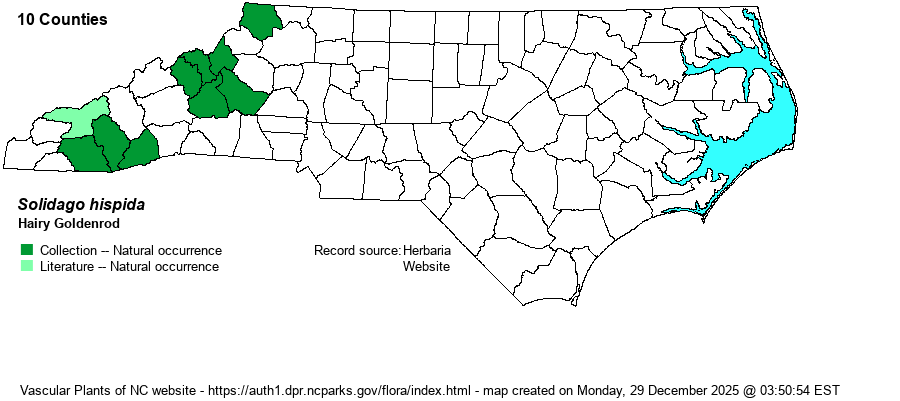| Author | Muhlenberg ex Willdenow | |
| Distribution | Mountains only, at middle to high elevations. RAB (1968) did not include this well-known species for North Carolina, owing to some confusion with the creamy-colored flowering S. bicolor, which it resembles.
Lab. to Sask., south to GA, AR, IA, and SD. | |
| Abundance | Weakley (2024) states "Widespread in e. and c. TN … and in nw. GA …. Also reported from NC and SC …." Though his map does show it as "rare" in the NC Mountains and Piedmont, there were no specimens at NCU until one collection from McDowell County in 2022 by Eric Ungberg. The BONAP map shows just one NC county -- Macon. There are other specimens in SERNEC, and the website editors have accepted those from higher elevations -- knowing that some might not be correctly identified. Very rare to rare; known from essentially just nine or ten counties (if even that many are correct!). This is now considered by NCNHP as a Significantly Rare species -- listed for the sole variety in the state. Even so, the near absence of specimens at NCU, considered our most reputable herbarium, is quite concerning, and gives pause to how rare the species is in NC. | |
| Habitat | Dry to mesic, rocky, montane woodlands, outcrops, balds. In mostly rocky, open, and exposed sites at higher elevations. The McDowell population occurs on a montane mafic glade. | |
| Phenology | Flowering and fruiting August-October. | |
| Identification | Hairy Goldenrod typically grows 1-2.5 feet tall. Basal and lower stam leaves are narrowly ovate to lance-shape, taper to winged stalks, and have small marginal teeth. Up the stem, leaves become gradually smaller and shorter-stalked. The inflorescence is spike-like, elongate, and has scattered small, bract-like leaves. In the field it closely resembles White Goldenrod (S. bicolor), but the stem is hairy (vs. rather smooth) and ray florets are yellow (vs. white to creamy white). Additional specimens of this species need to be collected and confirmed in herbaria, as its status in the state is still unsettled, despite it being a long-known, always-valid species! | |
| Taxonomic Comments | In some older texts, treated as a variety of S. bicolor.
| |
| Other Common Name(s) | None | |
| State Rank | S1 | |
| Global Rank | G5 | |
| State Status | [SR-P] | |
| US Status | | |
| USACE-agcp | | |
| USACE-emp | | |

